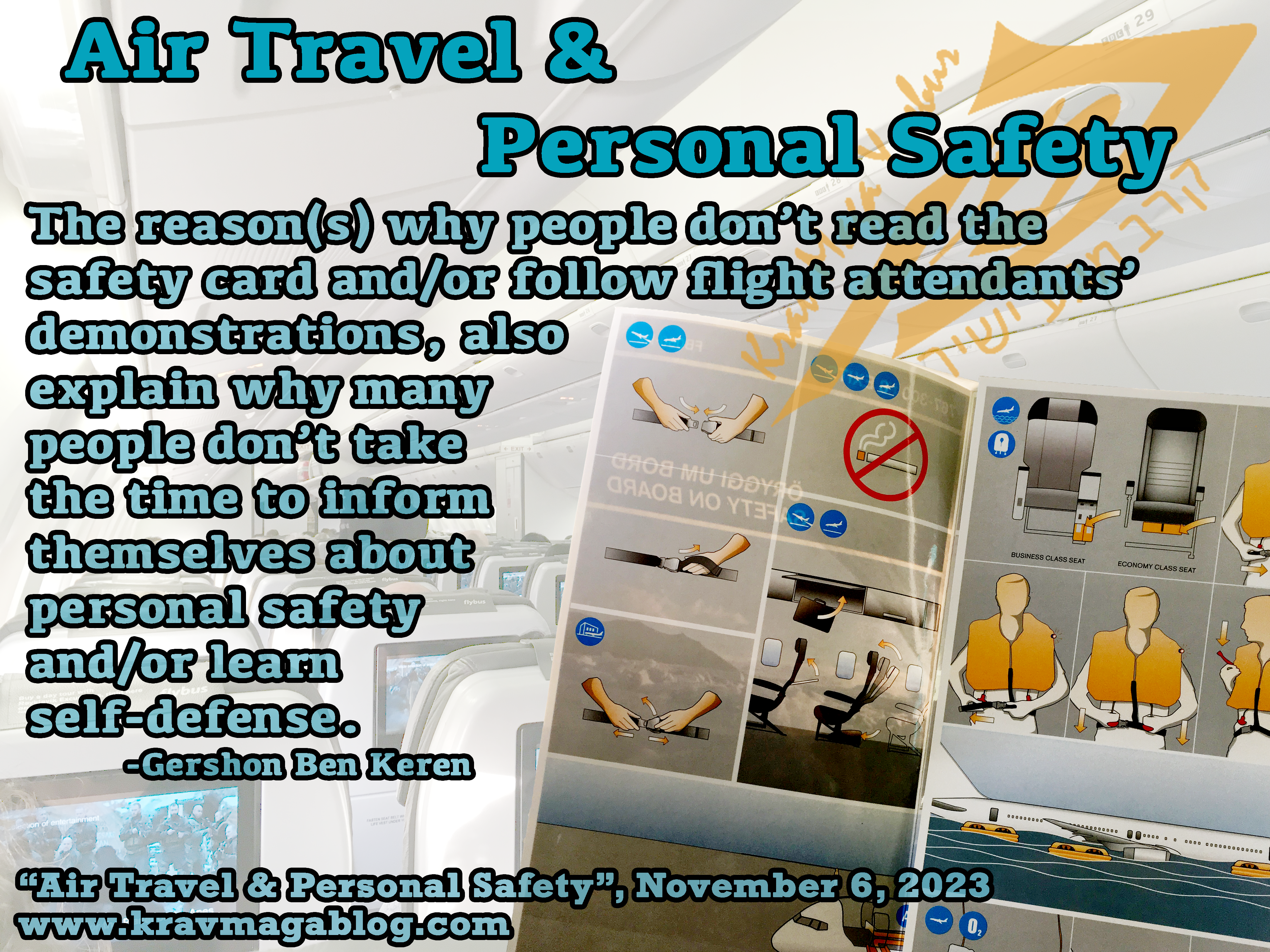Author: Gershon Ben Keren

I recently saw a meme of a dog – probably a comfort/service animal – sitting on a plane, looking at the flight attendant in the aisle giving the safety demonstration; it was captioned, “The only one on the plane watching the safety demonstration.” These safety measures/instructions along with the safety cards in the seat pockets are often ignored by passengers. Airplane safety cards were first introduced in the 1960’s and then were made mandatory in the US in 1978. Originally text heavy, they sometimes took the form of booklets, rather than cards – and were rarely read. They are still rarely read, despite a lot of work and analysis going into their design e.g., it was found that when images more closely resembled “people” rather than simple doodles, passengers more closely related to the imagery and were more likely to read them. However, they are still rarely read, and the flight attendant’s demonstrations of what to do in an emergency rarely watched. The reason(s) why people don’t read the safety card and/or follow attendant’s demonstrations, also explain why many people don’t take the time to inform themselves about personal safety and/or learn self-defense. In this article I want to look at some of the parallel reasons why people ignore safety information when flying and in daily life.
One airline safety organization found that there was an 80% failure rate when conducting in-person lifejacket donning tests. They found that many people assumed that a lifejacket was a lifejacket and that those used in maritime activities were the same, and worked the same, as those used in aviation. People thought that they already knew how it all worked and so didn’t need to be instructed as to how to put one on and therefore didn’t bother to watch the flight attendant’s demonstration and/or read the safety card. Studies have also shown that many passengers don’t really understand the speed with which an oxygen mask needs to be deployed e.g., some study participants thought they had several minutes, as opposed to times that may be as short as twenty seconds. Such individuals believed that they would have the time to work out in the moment what they would need to do in order to survive etc. I have lost count of the conversations I’ve had where people have made the argument that personal safety is just “common sense”, and that they’re very good at figuring things out in the moment etc. They fail to recognize that offenders, including violent offenders, are usually operating to a script that doesn’t match up with common sense, in very fast moving and dynamic situations where time is of the essence. For example, the person who has become highly emotional and aggressive due to something you have done/said or they perceive that you’ve done or said is not acting rationally and is probably not in the right space to receive your common sense explanation of things. This situation will develop so rapidly, with events overtaking you that you won’t have the time to work out what you should do in that moment. In aircraft emergencies, people have been shown to head for the exits where they boarded the plane, rather than the nearest ones. Without educating ourselves as to where the nearest exits are, we are likely to rely on memory, and head to where we remember there was an entrance/exit. So, to believe that we will work out what we should do in the “moment” – everything will be alright on the night – is a naïve viewpoint/perspective.
There are also those who don’t want to acknowledge the possibility of having to deal with an air disaster, because it would spoil their flight/trip. These are often the individuals who take a fatalistic approach to air travel, believing that there is probably nothing they can do anyway, should the aircraft hit problems. The truth is, according to the National Transportation Safety Board (NTSB) more than 95% of passengers involved in air traffic disasters/crashes survive. One of the simplest things that a person can do to try and ensure that they are part of this 95% - rather than being part of the 5% - is to start moving as soon as the plane comes to rest i.e., don’t sit in the seat waiting for the flight attendant’s instructions. Taking control, deciding to move, and acting upon this rapidly increases a person’s chances of surviving a crash. As does knowing how to operate the doors - and these can differ considerably between aircraft - another reason to read the safety card and familiarize yourself with the operation of them before you take off, and possibly before you are due to land; these are statistically the riskiest parts of a flight.
Likewise, predicting, preventing, and even dealing with most forms of aggression and violence we may face doesn’t have to be complicated; there are always simple things you can do to increase your survival chances. Whilst the psychology behind de-escalation and conflict resolution can be quite involved, the actual processes of doing so are extremely simple and straightforward.
The card in the seat pocket, and the safety demonstrations by the flight attendants may be seen as too simplistic and not worthy of our attention but observing them increases our survival chances considerably. Even if that’s only because somewhere in our mind we have recently considered the slim possibility of having to deal with a disaster and have acquired or reacquainted ourselves with the knowledge of what to do if that were to happen. As with all potential risks and dangers, we should not adopt the mindset that because our experience of flying has always been without incident that every flight we take will follow this pattern but rather accept that there are certain risks to every activity we engage in and we should be prepared to mitigate, manage and handle the situations we potentially face.